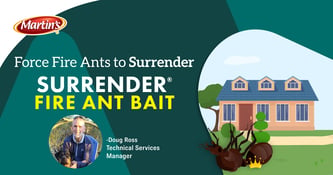Summer’s approach often brings a sudden, startling increase in flies. One day you’re enjoying some backyard barbeque, and the next you’re swatting flies.
Effective fly control requires using several practices and tools, including sanitation, traps and insecticides. While it may not be possible to use all of these, no single one will be enough. So, use as many as you can.
First, you need to stop producing flies on your property. Flies lay their eggs in wastes such as animal (dog, horse, cow and chicken) manure, spilled feed, piles of decaying vegetation, neglected compost piles, garbage cans and garbage heaps, where the larvae (maggots) grow and develop into new flies. Remove as many of these wastes as possible, and apply an insect growth regulator (IGR) like Martin’s I.G. Regulator to any remaining wastes to keep maggots in them from becoming adult flies. Eliminating these fly sources will do most of the heavy lifting in your control program.
Next, consider fly traps. A variety of traps are available. Some snare flies on sticky surfaces, while others lure them to their death using attractants. Many are quite effective, capturing and killing thousands of flies. Place traps near fly problem areas and higher than animals can reach. Traps also help monitor fly populations so you know when to use insecticides.
Fly control insecticides fall into three categories: baits, residual sprays and mists. Baits are sugar-based materials containing attractants and an insecticide. Granular baits like QuikStrike® and QuickBayt® can be scattered around the outside of farm buildings or used in bait stations. Flies are attracted to baits, feed on them and die.
Residual insecticides like Cyzmic CS and Bifen I/T are applied to surfaces of barns, stables, and other places where flies land and rest, such as walls, ceilings, floors, trash bins, manure, bedding, PVC, conduit, and shaded areas. For smaller areas, Martin’s Pen & Poultry is a ready to use product that comes in a convenient pump sprayer.
To quickly knockdown adult flies, fog or mist products like Stryker 5-25, Permethrin 13.3%, or Permethrin 10%. The mist or fog filling up the air in the barn (even over animals) will contact the flies, which will drop to the ground quickly, for nearly instant relief. Pystol Farm & Dairy Aerosol is a ready to use aerosol for this same purpose.
To protect horses, cattle and sheep from flies, you can treat the animals directly using pour-ons such as Fly-Ban and Cy-Ren or diluted sprays made with Permethrin 13.3% and Permethrin 10%. These products will help protect the animals from flies and can be reapplied as needed.
Using a variety of strategies to control flies is the best policy. Attack the fly problem from the source (waste materials) first with insect growth regulators and then focus on adult flies. Let Control Solutions be your trusted advisors on fly control on your farm and in your back yard.
QuikStrike® and QuickBayt® are registered products of Starbar.
Danny McDonald, Ph.D. Tech Services Manager, Animal Health

